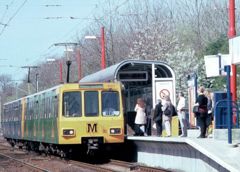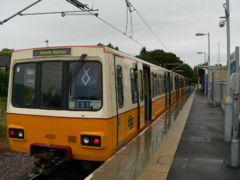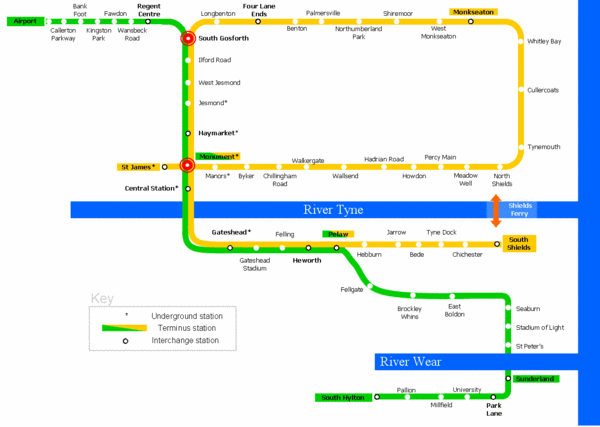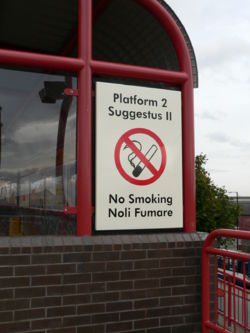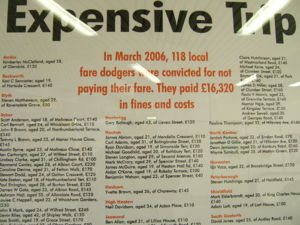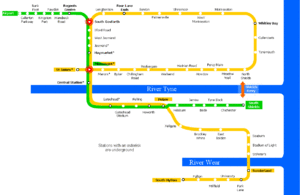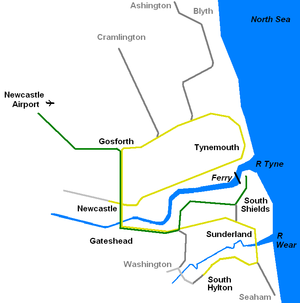Tyne and Wear Metro
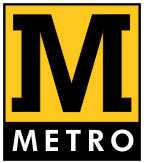 | |
| Locale | Newcastle and Sunderland, England |
|---|---|
| Transit type | Light rail |
| Began operation | 1980 |
| System length | 77.7 km |
| No. of lines | 2 |
| No. of stations | 56 |
| Daily ridership | 129,000 |
| Operator | Nexus |
The Tyne and Wear Metro (known simply as the Metro) is a light rail metro system based around Newcastle upon Tyne and Sunderland, in the county of Tyne and Wear in North East England. It opened in 1980, and in 2005-6 provided 36.6 million journeys on its 77 km route.[1] It is operated by Nexus, previously known as the Tyne and Wear Passenger Transport Executive (TWPTE). Nexus also operate a passenger ferry service at the mouth of the River Tyne between North Shields and South Shields, and several bus services around the Tyne and Wear area.
Contents
Overview
The Metro is usually described as Britain's first modern light rail system. However, it can be considered a hybrid system, displaying elements of light rail, heavy underground metro, and longer-distance, higher speed suburban and interurban railway systems.
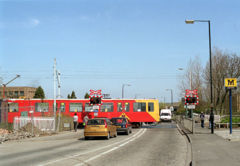
The Metro began operating in 1980, but was an evolutionary development, as it was a pioneering system in the use of existing rights-of-way to create a modern rail transit system, linking them with purpose-built tunnels under central Newcastle and Gateshead. Much of the Metro's route was part of one of the world's first electric urban railway systems, which opened in 1904 on passenger lines that were then already well established (see Tyneside Electrics). The Metro alignment comprises most of two of the world's oldest passenger railways, the Newcastle & North Shields Railway (Metro between Chillingham Road and North Shields) and the Brandling Junction Railway (between Gateshead and Monkwearmouth, near Stadium of Light), both opened in 1839, making the Metro arguably one of the world's oldest local rail transport systems. In the case of Metro's Chichester station, the route of an existing mineral railway was chosen instead of the previous passenger railway alignment, as it passed through a more heavily populated area than the previous High Shields station. This is also the oldest section of the Metro route, dating back to 1834.
With the opening of the Sunderland extension in 2002, the Metro became the first UK system to implement the Karlsruhe model, using track shared with mainline trains on the section between Pelaw and Sunderland. The section from Sunderland to South Hylton was previously part of the Sunderland to Durham mainline, closed in the wake of the Beeching Axe in the 1960s, and was the second Metro segment to be built on a completely disused line, following on from the Newcastle International Airport extension, which was largely built on the former Ponteland branch line.
When the Metro first opened, it was claimed to be part of the UK's first integrated public transport system. The Metro was intended to cover trunk journeys, while buses were reoriented toward shorter local trips, tightly integrated with the Metro schedule, to bring passengers to and from the Metro stations, using unified ticketing. Much was made of the Metro's interchange stations such as Four Lane Ends and Regent Centre, which combined a large parking facility with a bus hub and Metro station; this distinction is no longer emphasized. Some passengers complained that the Metro integration was pursued overzealously, and for example, bus passengers to Newcastle would be forced to change to the Metro in Gateshead for a short trip, rather than have the bus route continue for a short distance further into Newcastle. Integration lasted until deregulation of bus routes in 1986. However, it is still possible to buy Transfare tickets which combine a Metro and bus journey.
The Metro has drawn criticism from environmental campaigners as it does not permit the carriage of standard bicycles, though there are now storage lockers for these at many stations. Only small folding bicycles are permitted.
The Metro long had a problem with fare-dodging on the system, due to the lack of inspectors on the trains. In recent years, the number of ticket inspectors has increased, and in 2005 the penalty fare for travelling without a valid ticket was increased from £10 to £20.
The "Stand clear of the doors please" announcement, which sounded before the doors started to close, was introduced in 1991. In 1996, a contest was held in which several mystery celebrities recorded the phrase, with a prize awarded for correct identification; these recordings were replaced by staff announcements after the contest ended. The phrase was replaced with "Doors closing" in 2004.
Rolling stock
The Metrocars owe much to similar German Stadtbahn vehicles, although they were built by Metro-Cammell in Birmingham (now part of Alstom). Prior to opening, the Metro's two prototypes (numbered 4001 and 4002; they are still in service) underwent several years of testing at the Metro's own test track on North Tyneside, opened in 1975. The track was also used to test cars for the Hong Kong MTR, also built by Metro-Cammell. However, to accommodate the larger size of the Hong Kong cars, a short above ground test tunnel had to be demolished. The test track was built on the route of an old mineral wagonway, and it is now home to the Stephenson Railway Museum.
The Metro uses the line voltage of 1500 V DC, which was previously used on the Woodhead Line but is now unique in Britain. Metro has a rated top speed of 80 km/h, which it attains on the rural stretches of the line. The vehicles have a minimum turning radius of 50 m, although there are no curves this tight on the system.
During the early years of Metro, cars were operated in single and double sets. As single set cars became overcrowded Nexus, operator of the system, resumed using two cars as standard. Single sets are used today, to operate the new Sunday service. Single cars became common during construction of the Sunderland extension when some units were taken for testing of the new track.
As from the 14th January 2007, single car services operate on Sundays.
Route
The Metro system currently consists of two lines:
- Green line - Newcastle Airport to South Hylton via Newcastle city centre, Gateshead, Sunderland city centre and continuing on to South Hylton.
- Yellow line - St James to South Shields via North Shields, Tynemouth, Whitley Bay, then looping back on itself and going south via the city centre again to Gateshead, the Jarrow and South Shields.
Originally there was also a Red line that ran between Pelaw and Benton, and a Blue line that ran between St James and North Shields. Additional trains ran on these lines during peak hours to increase the service frequency at the busier stations; they also made sense in the context of the extensions that were mooted at the time the Metro was opened. Many of these additional services still operate today, but are now considered Yellow line services.
Before December 11, 2005 the Yellow line was a route that ran from South Hylton to St James and the Green route ran from South Shields to Airport but this was changed to accommodate a new timetable system. The routing shown above was introduced due to lower than expected passenger numbers on some parts of the Sunderland extension, as well as to streamline operations on the section shared with National Rail trains; as the shared section is now part of the shorter Green line, it is expected that delays along that section by mainline trains will have less overall effect on Metro scheduling.
- See also: List of Tyne and Wear Metro stations
Notable features
- The Tyne and Wear Metro was the first railway in the UK to operate using the metric system; all its speeds and distances are measured in metric units only.
- Smoking has been forbidden on the entire system since service began; this was one of the first comprehensive smoking bans.
- Wallsend station is probably the only public facility in Britain in which the signage is in Latin. Artist Michael Pinsky was commissioned to create the bilingual signs, along with a map of Hadrian's Wall in the style of the Metro map, to commemorate the area's Roman heritage and its location near the Segedunum Roman fort at the end of the wall. The project was part of Newcastle and Gateshead's unsuccessful joint bid to become European Capital of Culture in 2008.[2]
- Before tunneling could begin, several disused mineshafts in Newcastle and Gateshead, some of them hundreds of years old, had to be filled in.
- Although the Metro opened in 1980, most of its route was previously part of one of the world's first electric suburban railways, which began service in 1904.
- The Metro could also claim to be perhaps Great Britain's oldest commuter railway and one of the oldest in the world. It incorporates almost all of two passenger railways that began operation in 1839: the Newcastle & North Shields Railway (Metro between Chillingham Road and North Shields), and the Brandling Junction Railway (Metro between Gateshead Stadium and Stadium of Light). Apart from engineering breaks, such as the time required for conversion to Metro, the two lines have been in continual use as passenger railways for over 165 years.
- The very oldest part of the Metro alignment has been in use for over 170 years — the section between the end of the tunnel approaching Tyne Dock and Chichester, which was part of the Stanhope & Tyne Railway, opened in 1834.
- The Metro is the first underground train network in the UK to install repeaters allowing customers to use their mobile phone in tunnels, an achievement that is being closely watched by the London Underground.
- The Metro pioneered the playing of classical music in some of its stations, which had a positive effect on reducing vandalism, as it was thought to drive vandals away. In 2005 the London Underground began to follow the Metro's example.
- For many years, the Metro was the only rapid-transit system in the world with a "pretzel" configuration in which a line crosses over itself and trains pass through the same station twice at different platforms, as Yellow line trains do at Monument. It was joined in 2006 by the Vancouver SkyTrain in Canada and the RandstadRail tram system in the Netherlands. Toronto had previously experimented with a pretzel configuration in 1966.
- Metro employs the Karlsruhe model between Pelaw and Sunderland, which means it shares tracks with heavy rail services, so-called because of its initial use in the city of Karlsruhe where the city's trams also operate on conventional railways lines.
- Metro is one of the few systems where the names of people convicted to fines for not paying their fare (fare dodgers or losers as they were referred to as on the original signs) are shown on posters in the stations in a kind of shameful exposure somewhat comparable to the stocks. This deterrent practice might create privacy concerns in certain countries however.
Opening dates
The system opened in stages:
- 11 August 1980 - Tynemouth to Haymarket (Newcastle city centre) via Whitley Bay and South Gosforth
- 10 May 1981 - South Gosforth to Bank Foot via Fawdon
- 15 November 1981 - Haymarket to Heworth via Monument and Gateshead
- 14 November 1982 - St James' to Tynemouth via Monument, Wallsend and North Shields
- 24 March 1984 - Heworth to South Shields via Pelaw and Jarrow
- 15 September 1985 - Kingston Park
- 16 September 1985 - Pelaw
- 19 March 1986 - Palmersville
- 17 November 1991 - Bank Foot to Airport
- 31 March 2002 - Pelaw to South Hylton via Sunderland
- 11 December 2005 - Northumberland Park station
- 11 December 2005 - Altered route: Airport to South Hylton/St James' to South Shields
- Expected 2007 - Simonside station between Bede and Tyne Dock
Current issues
Timetable constraints
Since the opening of the Sunderland extension, Nexus found that the standard of service across the Metro network fell. This was mainly due to Network Rail stipulations requiring metro services to be timetabled at least three minutes apart from the mainline trains at Pelaw and Sunderland. The stipulations mean that it is difficult for Metro services to run to a regular timetable.
Nexus decided to reduce the number of mainline services between Sunderland and Newcastle from 36 per day to 22 effective from 11 December 2005. This allows metro trains to run at evenly spaced 12-minute intervals throughout the day between Sunderland and Newcastle.
Poor patronage on Sunderland extension
The patronage on the section of the route between University and South Hylton has failed to meet targets. In 2004–5 less than half the passengers predicted to use the service between these two points did so. In addition, passenger numbers have fallen on this section since 2003–4. This has led Nexus to introduce a 50% reduction in services between University and South Hylton, again effective from December 2005. One possible reason for the lack of patronage is that there are only four stations outside of the city centre, and thus the vast majority of people who live in Sunderland would have to first take a bus to the centre of South Hylton, then a metro or train.
Corporate identity and livery
From the beginning, the Metro system employed a distinctive design and corporate identity, in part to distinguish itself from the decrepit rail system it replaced, but also to match the livery of the bus system then in use. The Calvert typeface, used for signage and in printed materials, was designed specifically for the Metro by Margaret Calvert (see [3]). The corporate identity was revised in 1998, de-emphasizing the Calvert font, and adding the word Metro to its M logo.
The Metro fleet was initially painted in a two-tone livery of cadmium yellow and white that matched the Metro station design of the time, as well as the livery of the Tyne and Wear bus fleet until 1986. In the mid-1990s a new colour scheme was introduced, with Metrocars painted solid red, green, or blue, with a yellow wedge at each end and yellow triangles on the doors. This scheme was modified slightly in 2005, in part to comply with safety regulations (the doors are now solid yellow).
In addition, many Metrocars have carried full-body advertising. The initial prototype, number 4001, has been repainted in its initial yellow-and-beige livery from 1975.
The future
The system's newest station, Northumberland Park, opened on December 11, 2005. It serves a new housing development between Shiremoor and the A19 Holystone Interchange, and is located adjacent to existing track between Palmersville and Shiremoor on the northern loop section of the yellow line. It also acts as a feeder station for Nexus' R19 bus service, supporting Cobalt Park business park, the Silverlink retail park, and North Shields.
A further infill station at Simonside, between Bede and Tyne Dock, has been planned for many years, and is scheduled to open in 2007.
Further plans call for Haymarket station in Newcastle city centre to be renovated as part of an overall improvement of the site; it will include leisure and retail facilities.
There have been many suggestions for further Metro extensions, but none of these are likely to be built in the near future. There are several reason for this. The Metrocars will need to be replaced by around 2015. The Sunderland extension was built without requiring any new trains, but any significant new extension would require new rolling stock.
In 2002 Nexus unveiled Project Orpheus, an expansion plan that would extend the Metro system by adding new sections using street running, thus changing the Metro into a high-end tram system. Nexus argued that this would provide a cost-effective way to introduce rail service to parts of Tyne and Wear the current Metro did not reach. The plan listed a number of routes, not all of which were to be built as rail lines; transitional bus services were envisioned that could be replaced by trams as demand increased.
However, the original Project Orpheus has been abandoned, possibly because of the government's present "value-for-money" policies for public transport. This increased scrutiny has affected expansion plans for other light-rail systems such as Manchester Metrolink, where an expansion scheme was halted even after construction had begun. Critics have said that government policies now overtly favour bus schemes. A Metro link to Washington failed to gain government backing, despite the existence of substantial railway rights of way to both Pelaw and Sunderland; preliminary support was offered only to a guided bus scheme.
Another project, to remove the last section of single track in the Metro system, between Pelaw and Bede, would cost around 12 million pounds, and would allow freight trains to use the Metro infrastructure. Again, the government has expressed doubts as to whether it considers this would be cost-effective. This however is included in a revised Project Orpheus. Along with the improvements to the current system, a Tyne and Wear Metro improvement and regeneration project is currently proposed with plans outlined in the following document. http://www.nexus.org.uk/wps/wcm/resources/file/eb95cc420317607/Project%20Orpheus.pdf
As of 2005, there has been discussion of a public-private partnership to raise the funds necessary to modernize the Metro system.
Suggested extensions
Among extensions proposed at various times, none of which is currently being considered, are:
- Washington, either via the disused Leamside Line or a new route. Present planning may lead to the Leamside Line being opened as a conventional passenger rail line instead. The government favours guided-bus service to Washington.
- Blyth & Ashington, running on existing little-used freight lines. Northumberland Park station is being built to provide a link to a potential new rail service to these communities; if opened, it will not be a part of the Metro system.
- Tyne Dock to East Boldon along one of two dismantled railway alignments could easily be added, as only a short distance lies between two Metro lines. This may be the most likely future Metro extension, but the lack of rolling stock makes it unlikely at present.
- Killingworth and Cramlington have been planned since Metro was on the drawing board, but would require widening of the busy East Coast main line to four tracks, which would be expensive, or a new alignment involving street running.
- Newcastle's west end would require entirely new track involving tunneling and bridging in hilly terrain; this would be very costly and is pehaps least likely to receive funding, though would probably have the highest potential ridership.
- Ryhope, in southern Sunderland, has been mooted as an extension using existing railway lines. This route is shown in the current Project Orpheus plans.
See also
- List of rapid transit systems
- List of Tyne and Wear Metro stations
- Collection of Google Earth locations of Tyne & Wear Metro stations (Requires Google Earth software) from the Google Earth Community forum.
External links
| Wikimedia Commons has media related to: Tyne and Wear Metro |
- Official Tyne and Wear Metro website
- Tyne and Wear Transport Group (fan site, with historical and technical information)
- How Metro could look in the future (Artists impression of what the new Metro system could look like. All images are of Haymarket with exeption of image 1.)
Local rail transport in the United Kingdom | |
|---|---|
| Metros | Docklands Light Railway (East London) · Glasgow Subway · London Underground · Tyne and Wear Metro |
| Tramways | Blackpool · Manchester · Midland Metro (West Midlands) · Nottingham · Sheffield · Tramlink (South London) |
